Picture-perfect! Autumn Colors of Karasawa
From Kamikochi, a popular resort area in the Northern Alps, we will head to Karasawa Cirque, one of the most beautiful places in Japan to view the autumn leaves. We will experience a unique mountain lodge built in the spectacular terrain created by glaciers and stay in tents, while enjoying the beautiful autumn of Japan in all its colorful glory. You will also learn the art of mountain photography.
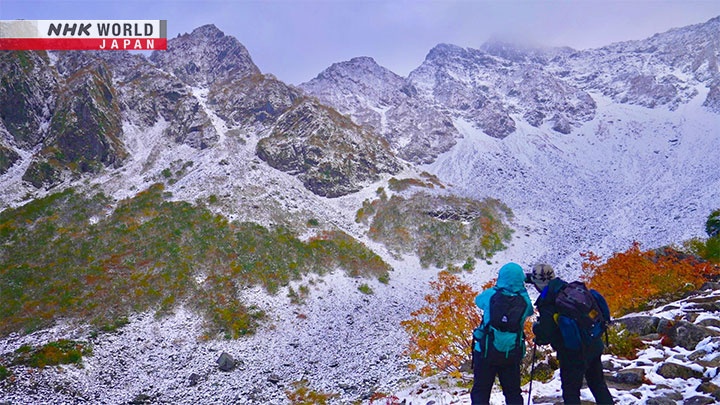
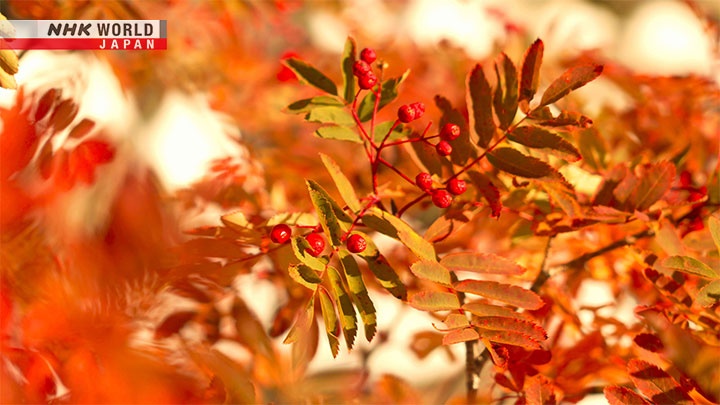
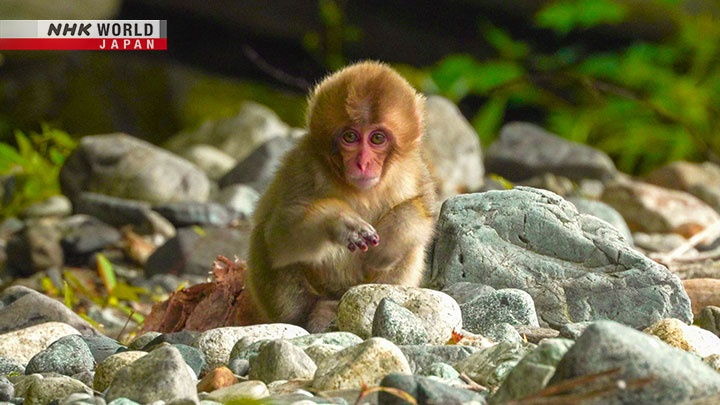
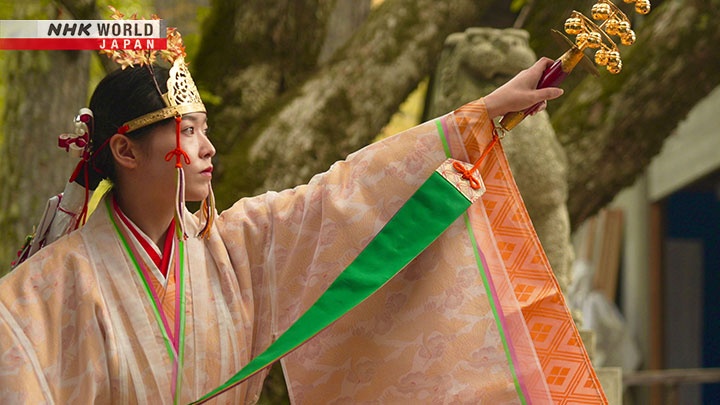
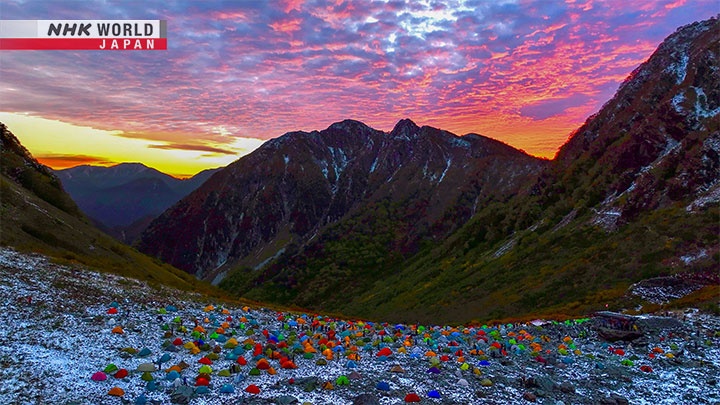
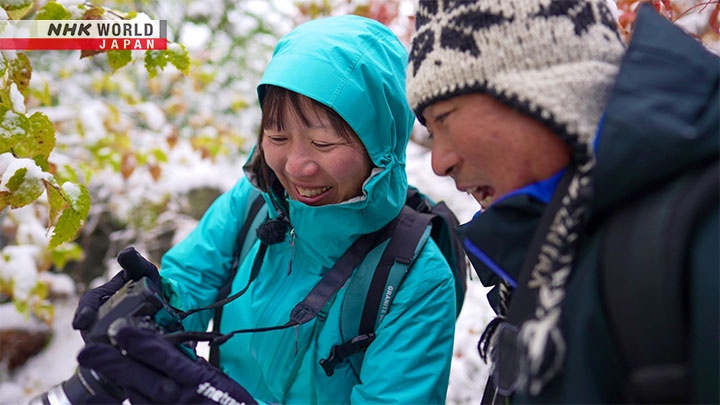
Transcript
Wow! What an incredible view!
Japan, a place where 70% of the land is mountainous.
Hiking is actually very popular here.
From beginners to experts, men and women of all ages are able to experience the wide diversity of nature that the mountains offer.
The trail we'll be hiking this time is easy and suitable for beginners
and is also known for its breathtaking views.
We'll leave from one of Japan's most famous mountain resort areas
and head out to Karasawa Cirque said to have one of the country's most beautiful autumn landscapes.
- It's like the perfect scene here.
- Oh yes yes, fantastic!
On this trip, we will bring our cameras along to capture beautiful moments as we hike.
- Nice!
- Good smile.
A spectacular natural landscape unlike any other along with people who love the mountains.
- Cheers!
- "Kanpai," cheers.
Let's go on a journey up in the mountains, to discover another very special side of Japan with "Let's Trek Japan."
This time, we will be heading to the central part of Japan's mainland
to the Northern Alps - a mountain range with 3,000m-high mountains.
The starting point of our journey is, Kamikochi, in Nagano prefecture.
Kamikochi is a nature conservation area where private vehicles are not permitted.
Only authorized buses and taxis are allowed.
Tourists and hikers can take convenient buses that go directly there
from major cities such as Tokyo or Osaka, also from near the area's entrance.
Kamikochi is the gateway to the Northern Alps, attracting many hikers.
Hi, my name is Pauline Kitamura, and I've been living here in Japan for more than 20 years
and I've fallen totally in love with the mountains in Japan.
I currently work as a hiking guide here,
and would love to share with you the joys of hiking in Japan.
We're headed to Karasawa Cirque.
Karasawa Cirque is very famous in Japan for its autumn leaves.
And right now, it should be at its peak.
We should be able to see some amazing, amazing colors.
I'm really really excited to head over.
It's raining right now, but we're gonna have a good time. Let's go.
We are now heading to Karasawa in early October, which is when the autumn leaves are at their peak.
We're hoping to see some spectacular views.
The hiking course is a 3-day, 2-night trip from Kamikochi to the Karasawa Cirque located at an altitude of 2,310m.
On the first day, we follow a river. At the 10km point, we enter a mountain trail.
After walking 16km, we arrive at Karasawa, known for its spectacular views of autumn leaves.
One night at a unique mountain lodge, the next day we will be staying in a tent.
It's not about reaching the summit.
We will be immersing ourselves in nature to fully enjoy the autumn foliage and beautiful views.
Wow! Look at the mountains!
It's absolutely beautiful.
The clouds are coming off the mountains right now.
This bridge here is Kappa-bashi.
And it's this famous symbol of Kamikochi.
A lot of tourists come here to take photos on this bridge and to get through the mountains in the background,
and it's very very beautiful.
Kamikochi is one of Japan's top mountain resorts with many luxury hotels.
Located at an elevation of 1,500m, it's cool in summer.
It is also a national park, where more than 1.2 million people come and visit every year
to enjoy the natural beauty of the Northern Alps.
Oooh... the water's so cold. Oh, it's freezing.
The water is this beautiful blue green color.
And it's very clear.
The source of this beautiful river is melted snow and rain that has fallen in the Northern Alps.
Our destination, the Karasawa Cirque, is located on the other side of the Hotaka Mountain Range.
To get there, we'll follow a long but relatively flat trail along the river that will take us around the mountain.
Look, here's the boardwalk.
We've got these long boardwalks all along here, and it makes it really easy to walk on.
And it protects the vegetation below.
Make sure to stay on the boardwalk
as we don't want to step on the rare plants that are protected by the national park.
Wow. Look at this!
So beautiful.
The river's flowing gently and it's so quiet.
The trees are growing out of the water,
and we've got the mountains in the background, and the peaceful river gently flowing.
It's like, it's like the trees were artificially put here.
And it's a landscape, a man-made landscape, a Japanese garden.
This is the Dakesawa Marsh.
Several streams have converged causing the water level to rise
and submerge the roots of the trees, creating a mystical landscape.
Oh look, fish! Over there.
Can you see? Right there!
The water is so clear.
Good Morning!
Look! A bear bell!
There are bears in Kamikochi, so I'm gonna give it a ring.
One for me, and another for the people around us.
In the mountainous areas of Japan, you may encounter bears.
In fact, many incidents of bear attacks have been reported.
As bears are sensitive to sound,
ringing a bear bell will help you avoid any unwanted encounters with bears!
However, the wildlife that you are most likely to encounter in Kamikochi
are Japanese macaque monkeys, a species native to Japan.
Although they are cute, do not feed them as this could cause them to lose their ability to find food in the wild.
It is our duty as humans, to protect these animals and the precious natural environment in which they live.
Oh look, it's a "Torii" gate.
Once you go through the gate, the area beyond the gate is considered sacred.
This is Hotaka Shrine, it protects the mountains.
Look. There's a small shrine where we could do a prayer right at the edge of the water.
When I first came to Japan, I was told that the Gods resided in everything in nature.
And that was kinda hard for me to grasp, coming from North America.
But after being here in Japan and visiting a lot of mountains,
and coming to places like this, you really do get the feeling that this place is special.
It feels sacred.
And you really do start to feel that, yes, the Gods do reside here.
Once a year, during autumn, usually in October, when the mountains start to change color,
a Shinto ritual is held at the Myojin-ike, a Pond.
People express their appreciation for blessings given to them by the mountains during the year
and pray for the safety of people who spend time in the mountains.
Next to the shrine is Kamonji-goya - a mountain lodge built in 1880.
Here you can taste the blessings of nature.
Fresh "iwana" mountain trout, inhabit the pure water that comes down from the mountains.
The fish are slowly grilled over a hearth using traditional methods handed down over many generations.
This is called an "Irori."
This sunken hearth is a traditional cooking area
that provides heating and lighting for a house and is a gathering place for families.
It is also considered a sacred place where the God of Fire dwells
and is carefully cared for as the guardian deity of a family home.
Here, hikers eat their fill, before continuing on their mountain journey.
Delicious.
Mmmm. The mountains and the water, allowing me to enjoy this really delicious fish.
After eating, we'll walk for another 2 hours through the forest to Yokoo-ohashi, a bridge at the 10km mark.
We made it! We're here.
This is Yoko'o Mountain Hut.
That was a flat trail, but a very long trail. Yay.
Yokoo Sanso, located 10 km from the start, is the last lodge before Karasawa.
Make sure to prepare for the remainder of the hike by filling your water bottles and stopping by the washroom.
Oh look, there's a sign by the bridge.
Do not start a hike after 2:00 PM for your safety.
Once we cross the Yokoo-ohashi bridge, we will begin hiking up a steep and rocky mountain trail.
It will take about 3 hours to reach Karasawa - our final destination.
We must pass the bridge by 2:00pm at the latest, to reach our destination while there's still daylight.
Once it becomes dark, the risk of accidents increases so it is very important to keep track of the time.
Before heading up the mountain, make sure that you have proper hiking gear.
A sturdy pair of hiking shoes are a must.
Mid-cut boots that go up to the ankle are recommended as there are many rocky sections along the trail.
Always carry rainwear and warm clothing.
Even if it's not winter, sudden rain or cold weather could put you at risk of hypothermia.
You will see the importance of this firsthand later on during this trip.
Wow! That's a huge cliff!
Really steep.
Towering before us is "Byobu-Iwa," one of Japan's largest rock walls rising to a height of 600m.
This huge granite rock wall was created by magma and is almost vertical.
It's revered by experienced rock climbers who dream of climbing it at least once in their lifetime.
Look at this!
Look how red that is. So beautiful.
As we increase our elevation, we're starting to see a lot of reds and yellows.
Even if you're tired, when you see beautiful scenery like this,
it just really keeps you motivated to keep going. Oh, look at this.
The leaves are so yellow.
This is why I like to climb mountains in the autumn.
In Japan, going into the mountains to view autumn leaves has been a custom for more than 1,000 years.
Japan has many places famous for their beautiful fall colors.
Autumn foliage viewing is a very popular activity.
Among them, our destination, Karasawa Cirque, is a particularly popular spot for viewing the autumn leaves.
Many people are hiking up to it, hoping to see this spectacular view.
What will it look like this time?
This rocky, steep trail is going to continue for the next 2 hours.
Although the hiking trail is well maintained to make sure there are no dangerous spots,
it is important to stay alert and carefully proceed, one step at a time.
As we continue to climb up the trail, to our surprise, it begins to snow!
The temperature drops down to 0 degrees Celsius which is unusually cold for this time of the year.
It's really starting to snow.
Ohh, it's freezing.
Ohh.
Ooof.
The snow fall is getting heavier but we're almost at the mountain lodge.
I see them! I see the mountain hut.
We're getting really close now.
Yes! We're here!
We made it. We're at Karasawa Hütte now.
Oh my gosh, I'm exhausted, but it feels so good to me, to have made it all the way to the top.
I'm gonna check out the rooftop terrace before I check in.
I can't believe this, there's so much snow up here.
This is really incredible.
Snow during the autumn climbing season in Karasawa is an extremely rare occurrence.
For the first night, we will stay at this mountain lodge,
and warm up at the Karasawa Hütte located at an elevation of 2,310m.
Hikers who came to see the autumn leaves also seem to be surprised at the unusual sight of snow.
I came here to see the autumn leaves.
I wasn't expecting a snowy mountain but it's very beautiful.
Our first time to see snow in the mountain,
and it's really wonderful, so I'm so surprised to see this view.
There's a shop that sells food on the terrace where people can enjoy their meals while enjoying the view.
For over 60 years, this has been the number one popular dish loved by hikers.
Made of eggs, daikon radish and fishcakes slowly boiled in a mild broth -
this is Japanese soul food, it's called "Oden."
After spending time in the snow and the freezing cold, the warm broth soothes and warms up your body.
This mountain lodge is located in a very unique spot even within Japan.
Spread out like a bowl below a row of 3,000m-high mountain peaks lies Karasawa.
This kind of terrain is called a cirque.
About 20,000 years ago, this area was completely covered by glaciers.
As a heavy glacier moved down the U-shaped mountains, it carved out a huge bowl-shaped depression.
With a diameter of 2km, the difference in elevation between Mt. Oku-Hotaka and the bottom of the bowl is 900m.
It is the largest glacial cirque in Japan
and the mountain lodge is built right in the middle, at the bottom of the bowl.
Actually, there's a reason why they built the mountain lodge in this location.
This mountain lodge is located
at the bottom of the bowl-shaped terrain
and is surrounded by four mountains
that are over 3,000 m high.
This is the best place to get a beautiful view of
the Hotaka Mountain Range.
In front of the lodge is Mt. Oku-Hotaka, the 3rd tallest mountain in Japan at 3,190m.
Also you can see Mt. Mae-Hotaka, Mt. Karasawa, and Mt. Kita-Hotaka.
This lodge was built in a rare and ideal location with a panoramic view of four 3,000m peaks.
Due to heavy snowfall, the mountain lodge is closed during the winter season
and only open to hikers for about 6 months of the year, starting from late April through early November.
It's challenging for them to maintain the mountain lodge at this location.
The first mountain lodge was built here in 1951.
However it was swept away and destroyed by avalanches 2 years in a row.
So the lodge staff came up with an ingenious solution to protect the lodge against avalanches.
Since avalanches would come in from all three directions,
my predecessors came up with the idea of piling up
stones to create a roof that was level to the ground,
so that the avalanches would pass right
over the top of the building.
They reinforced the building with a stonewall and built the entire mountain lodge basically underground.
The terraces and other exposed areas are dismantled every year to prepare for avalanches.
During winter, the entire lodge is covered with snow.
Once winter ends, the most important job of the year for the lodge staff is to dig the lodge out from under the snow.
The most exciting time of the year
is when we re-open the lodge.
It takes us about 10 days to dig out
the building from under the snow.
It's physically exhausting, but when the various
parts of the building start to reappear one by one,
I feel happy that the mountain lodge
were able to withstand tons of snow.
In late April, as winter ends, many hikers will pitch their tents outside even if there's still snow on the ground.
During summer time in July, alpine plants are in full bloom and the landscape is filled with flowers.
And then comes autumn.
During late September to early October, autumn leaves are at their peak.
Many hikers will come here to catch a glimpse of this incredible view.
I do this job with the hope that more people
will come to see this wonderful scenery.
Okay let's check in.
Hello.
- Hello, do you have a reservation?
- Yes, I do.
Most mountain lodges require reservations.
Spaces fill up quickly especially during the popular autumn season,
so make sure to check the lodge's website for open spots before you go.
In most cases, only cash is accepted up in the mountains so credit cards are useless.
Make sure to have Japanese cash beforehand; you can exchange at an airport or a city center.
In Japan, it's common to take off your shoes indoors.
This applies at mountain lodges as well.
So now we are gonna head to our room.
We go down this hallway... Look at this!
Futons neatly set up in each section.
We're going up these stairs.
- Hello.
- Hello.
Mountain huts in Japan often have shared rooms like this...
beside a stranger, but if you talk to them, you could become friends with them.
And just be considerate of others when you're sharing a room.
Many mountain lodges do not have beds, so you'll need to lay out the futons they provide!
At lodges, the futon sheets are reused so bringing your own inner sheet
can help maintain cleanliness and allow you to sleep more comfortably.
Dinner at the lodge is served at specific times.
Make sure to confirm the time upon check-in.
The meals provided are nutritionally balanced for hikers.
Normally, the lights go off at the lodge at around 8 or 9 PM.
Be considerate of those around you and enjoy the evening quietly.
Wow...
my goodness, look at this!
What an incredible view.
The mountains are covered in snow, just all around us.
And it's like a winter wonderland - it changed overnight.
On our second day, we venture into a rare and spectacular world where autumn leaves and snow coexist.
We asked an expert who knows Karasawa like the back of his hand to guide us.
- Hi, nice to meet you Mr. Oguchi.
- Nice to meet you. Hi, I'm Oguchi.
Good to meet you.
Please take care of us.
I've brought my camera with me.
Oguchi Kazutoshi is a mountain photographer who has taken magnificent photos,
not only of Japan's peaks but also the majestic mountains of the European Alps and the Himalayas.
He fell in love with the scenery in Karasawa
and has since come back every year to capture its four seasons with his camera.
This is the first time in 20 years that snow has fallen in Karasawa during the autumn foliage season.
This is incredible.
The sunlight shining on the autumn leaves
make the colors even more vivid.
And the pure white snow around us.
It's almost unbelievable!
I've captured the autumn leaves
in Karasawa dozens of times,
but this is the first time I've seen this place
covered in snow like this.
That's why I'm so excited right now.
One way to enjoy hiking is through photography.
Our hiking photography adventure starts now!
We will learn the secrets of mountain photography from Oguchi while hiking around Karasawa.
- Pauline-san, look!
- Wow.
Beautiful.
And the mountain has snow on the top.
I can see some orange down there, reds, yellows, and green.
And then the background there, we see snow-capped mountains with a blue sky above it.
- It's perfect.
- Okay, we'll take a picture here.
Okay.
- I'll grab the camera.
- The wide lens is better.
Wow, beautiful.
It's like the perfect scene here.
From here on, we will walk along a trail covered in snow
to discover the beautiful scenery buried under a silver veil.
Lightweight crampons that can be attached to your shoes, are indispensable when walking on snow.
The metallic spikes dig into the ground, providing stability and make it safer to walk.
Oh look! It's so beautiful.
Oh yeah, beautiful, beautiful.
This hiking trail was also made by the mountain lodge staff so that hikers can enjoy Karasawa from various angles.
The path is regularly maintained to make sure there are no dangerous spots.
Look at this.
There's so much snow on this Japanese pine tree called "Haimatsu."
"Haimatsu" is a shrub that grows very low to the ground in alpine regions.
It is an evergreen conifer.
Pauline-san, this part is a tree tunnel.
We go, okay?
The next photo spot Oguchi is taking us to is a tunnel of colorful autumn leaves.
Oh, this is so beautiful. Look at this.
It's a tunnel. A tunnel of red leaves, yellow leaves, green leaves, and snow.
Pauline-san, you go first.
Go ahead and I'll take your picture.
Placing a person in the middle of a picture of colorful autumn leaves and snow,
looks like they have become part of the autumn leaves, which makes for a very impressive photo.
- Ohh, Mr. Oguchi, can I take a photo of you too as well?
- Oh, thank you very much.
Ready?
Okay, one more, one more.
Okay, thank you.
- Ooh, nice! Nice!
- Good smile.
Black bear.
The next thing Mr. Oguchi is showing us is this cute rock that is known as the mascot for the Hotaka Mountain Range.
Pauline, do you see the rock over there that is sticking out?
We call that rock the "Tanuki" Rock.
Can you see the "Tanuki" raccoon?
It is sticking its belly out to the left.
I see it! The raccoon.
That's the famous rock.
And here is a special spot that Oguchi really wants to show us.
Wow, this is a special spot.
This pond.
- Very nice... This is a fantastic viewpoint.
- Very nice panorama.
Panorama? A bowl.
It feels like I'm inside a bowl. A nature bowl.
So when you look at this side over here, you've got the red leaves, yellow leaves,
green leaves, and it's like autumn over there.
And then you turn around to this side, and you see mountains, snow-covered mountains.
And it's like winter over here.
So it's like I have two seasons in both hands.
It's an amazing thing to see.
The best part of taking photos while hiking
is that we get a snapshot of each unique moment during the changing of the seasons.
It's just so worth the hike to come here and see this.
- Thank you so much for bringing me here.
- Yeah, I'm happy also.
I'm so happy you brought me here!
Yeah... good day.
The trail continues to follow the colorful trees.
Pauline-san, look, there's the so beautiful "Nanakamado." Very colorful.
The star of this beautiful show is the bright red Japanese "Nanakamado."
There are so many "Nanakamado" growing
in the Karasawa cirque.
You can also see a lot of yellow-colored Erman's Birch.
Another important color is the green from "Haimatsu."
The pine's green color brings out the colorful leaves.
The balance that you see in Karasawa is magnificent.
And the pattern created by mountains and the autumn leaves,
I really think this balance is absolutely beautiful.
Pauline-san, look at that.
- And this is "Nanakamado's" seed, this is seed.
- Ohh, seed.
Ooh, close up, okay.
With photography, we are able to focus on the micro side of this impressive nature, which we tend to forget.
Let's take a closer look at the plants below our feet.
This vast wide world and the small world in front of us.
You can feel the difference while being in the same place.
It's a very interesting world.
But you will miss this if you don't pay attention.
I wouldn't have even noticed, if you didn't tell me.
If you are able to have different perspectives,
you can enjoy the variations even more.
Thank you.
By taking a photo, we can freeze this amazing moment of these ever-changing mountains into a single image.
Oguchi is one of the many who are mesmerized by Karasawa.
I was about 20 when I first came to Karasawa,
so that's about 50 years ago.
Half a century.
The awe that I felt when I visited Karasawa back
then remains just as profound,
regardless of how many times I've returned,
or how many years have passed.
Especially when you witness a snowscape like
the one we encountered on this trip,
it's a level of wonder I've never experienced before.
It's beyond what I could have expected.
There's a world out there I probably haven't even seen yet.
With that in mind,
I hope to keep climbing as long as I can,
always anticipating what lies beyond,
and seeking the unexpected.
I'm so grateful for this beauty...
you know, by coming here, I feel...
I guess I'm just very happy.
Most people come here looking forward to this one single thing.
Countless colorful tents are scattered around the landscape.
At its peak, there will be over a thousand, almost looking like a jewelry box at night.
For our second night, we will be camping at a campsite that's next to the mountain lodge.
Here, you can hire out tents and sleeping bags, and the staff can assemble the tent for you.
It is better to phone them and book in advance.
This is my rental tent for tonight.
And as you can see, the campground here is really really rocky.
But when you look underneath the tent here,
there's a wooden board, and this comes with the rental tent.
So with that underneath it, it's very flat and comfortable.
I think the beauty of this place is that you can enjoy both
the autumn leaves and the scattered tents in one view.
The snowy scenery. This is such a panoramic view,
everywhere you look is breathtaking.
The hardships we faced while hiking, I found myself
in tears right here just a little while ago.
This is Japan's most beautiful autumn leaves.
I've been alive for 72 years and...
I think it is the best feeling I've ever had...
It is just amazing.
The best part of camping is that you can cook and eat in the midst of serene nature.
Ramen is something that Pauline often makes when she's up in the mountains, and it is a dish that keeps you warm.
All the ingredients can be bought at convenience stores.
Oooh, that looks good.
Mmm. Nice and hot, and tasty.
Sit outside, watch the mountains around you, and have a warm ramen noodle dinner.
This is why I love camping.
As it gets darker outside and the lights start to turn on inside the tents, the landscape starts to glitter.
When you spend the night here, you can also sparkle like a jewel.
- Hi Oguchi-san, thanks so much for today.
- Pauline-san!
We invited Oguchi to our tent to thank him for today.
So we make a toast with local wine.
Cheers!
This is delicious.
I'm so happy that you were able to see
this really special scenery of Karasawa.
Really, me too. Thank you so much.
Cheers!
Pauline-san, I see stars out.
Wow.
I can see so many stars out.
You can't see this in the city at all.
It's because we're in Karasawa that we can see so many stars like this and it's amazing.
Ooh, very nice, very nice.
Wow! Oh my gosh I can't believe you've captured this on your camera.
- Okay, with your camera.
- With my camera?
Three, two, one, zero.
Wow, the silhouette of the mountains and the stars above it, it is so beautiful.
There are many, many stars.
Cassiopeia there, there.
We were able to capture an image of Cassiopeia, the W-shaped constellation signifying autumn at night.
There's just stars all over.
Karasawa Cirque is surrounded in a bowl-shaped form
by mountains more than 3,000m high.
With that, you are able to see a truly circular night sky
above the silhouettes of those mountains.
Look at this, a spectacular, one of a kind starry night.
I think being surrounded by
the Hotaka Mountain Range is
what makes Karasawa's starry night special.
Fantastic. Fantastic planetarium.
- Oh! A falling star! Did you see it?
- That was a falling star!
I just saw a falling star.
This is the first time I saw a falling star.
The next morning, at 5:30, hikers wake up early to enjoy a very special moment.
Good morning. I'm up early in the morning to hopefully see what we call "Morgenrot."
Really excited, cause everyone's here.
Everyone gets up really early in the morning to see this.
And then the moment arrives...
I'm starting to see some red up on the mountains there.
The sun is coming up.
Oh it's coming.
"Morgenrot" occurs early in the morning when the sun rises from the east
and the rays from the sun illuminate the mountain range making the mountains appear to glow red.
This phenomenon is named after the German word for "morning glow."
This beautiful sight can only be seen for a few minutes.
Oguchi also didn't miss the moment when the mountains looked their most beautiful.
Oguchi has photographed this phenomenon in Karasawa many times.
The Hotaka Mountain Range shows a new side of itself every day.
To see this magical early morning view is a privilege only for those who have spent the night in Karasawa.
At that moment, the sun that has been hiding appears, shining on the mountains of Hotaka.
Wow.
Oh...
so beautiful.
It's bright out, it's sunny out, and the weather's perfect.
I'm able to see the entire Hotaka Mountain Range.
All the peaks, snow-capped peaks, and the blue sky.
I've been to a lot of mountains in Japan, but this is my first time in Karasawa.
And as we got closer, it started to rain, and then it started to snow,
and I'm thinking "Oh my goodness. Would I be able to see autumn?"
And then the next day, the sun comes out, and I can see blue sky,
and snowy mountain peaks with autumn leaves below it.
And it was just this most amazing, spectacular scenery of fall and winter coming together.
I also met Mr. Oguchi who gave me some really great photography tips to be able to capture this on my camera.
If you come to Japan, I would highly, highly recommend coming here
because it's such an amazing way to experience the Japan Alps.
Today's hiking route is about 16km one-way to Karasawa.
Let's make sure to pay attention to the trail when we are walking back.
Aside from the mountains being closed due to snow in winter, from late April to early November,
you can enjoy every season with its unique beautiful scenery, including spring, summer, and fall.
When hiking, don't forget to hand in your hiking itinerary.
This has your planned route, hiking member's information, and emergency contact.
This is key when rescuing people from being stranded if need be.
The form can also be submitted online.
Once you're prepared, let's go up into the mountains of Japan!